Solar eclipse of April 6, 1875
| Solar eclipse of April 6, 1875 | |
|---|---|
 Map | |
| Type of eclipse | |
| Nature | Total |
| Gamma | -0.1292 |
| Magnitude | 1.0547 |
| Maximum eclipse | |
| Duration | 277 sec (4 m 37 s) |
| Coordinates | 0°12′S 84°48′E / 0.2°S 84.8°E |
| Max. width of band | 182 km (113 mi) |
| Times (UTC) | |
| Greatest eclipse | 6:37:26 |
| References | |
| Saros | 127 (50 of 82) |
| Catalog # (SE5000) | 9222 |
A total solar eclipse occurred on April 6, 1875. A solar eclipse occurs when the Moon passes between Earth and the Sun, thereby totally or partly obscuring the image of the Sun for a viewer on Earth. A total solar eclipse occurs when the Moon's apparent diameter is larger than the Sun's, blocking all direct sunlight, turning day into darkness. Totality occurs in a narrow path across Earth's surface, with the partial solar eclipse visible over a surrounding region thousands of kilometres wide. Totality was visible on the southern tip of Africa, across the Indian ocean, and across southeastern Asia.
Observations
Astronomers J. N. Lockyer and Arthur Schuster traveled to observe the eclipse and measure spectral lines to determine the elemental contents of the solar corona.[1]

Related eclipses
Saros 127
It is a part of Saros cycle 127, repeating every 18 years, 11 days, containing 82 events. The series started with partial solar eclipse on October 10, 991 AD. It contains total eclipses from May 14, 1352 through August 15, 2091. The series ends at member 82 as a partial eclipse on March 21, 2452. The longest duration of totality was 5 minutes, 40 seconds on August 30, 1532.[2]
| Series members 52–62 occur between 1901 and 2100 | ||
|---|---|---|
| 52 | 53 | 54 |
 April 28, 1911 |
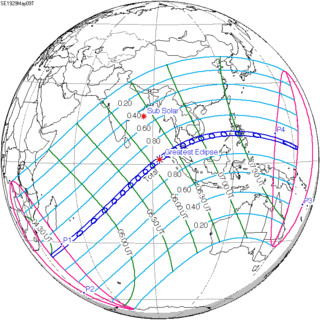 May 9, 1929 |
 May 20, 1947 |
| 55 | 56 | 57 |
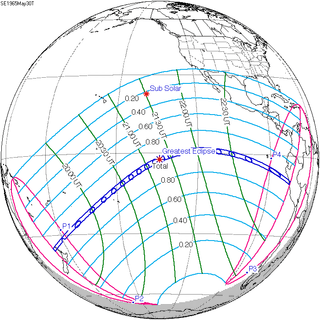 May 30, 1965 |
 June 11, 1983 |
 June 21, 2001 |
| 58 | 59 | 60 |
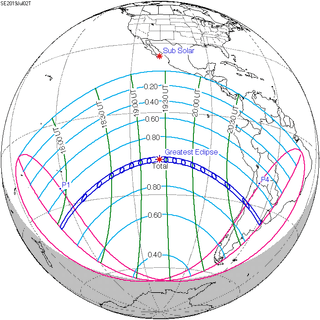 July 2, 2019 |
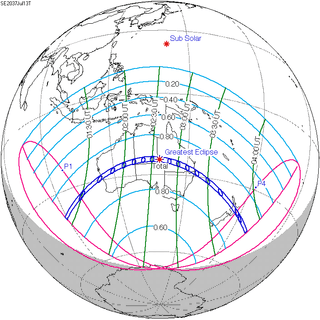 July 13, 2037 |
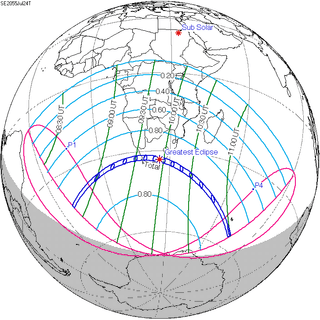 July 24, 2055 |
| 61 | 62 | |
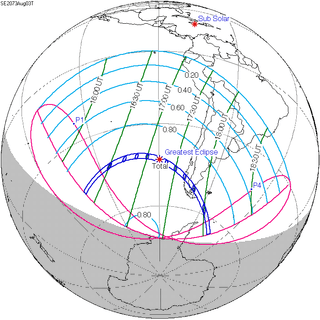 August 3, 2073 |
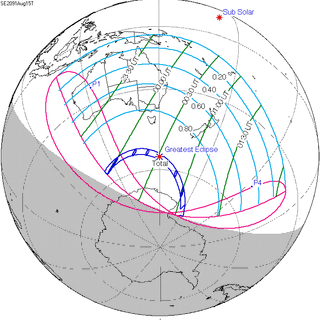 August 15, 2091 | |
Notes
- ↑ Report on the Total Solar Eclipse of April 6, 1875 by J. N. Lockyer and Arthur Schuster, 1878, The Royal Society
- ↑ http://eclipse.gsfc.nasa.gov/SEsaros/SEsaros127.html
References
| Wikimedia Commons has media related to Solar eclipse of 1875 April 6. |
